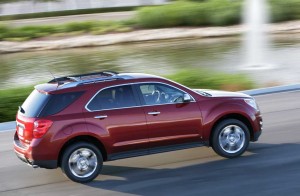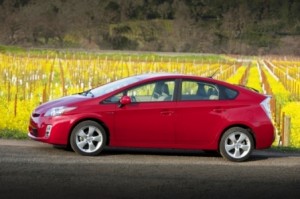
Sales of GM products, like the Chevrolet Equinox boomed during February, with especially strong retail demand.
Automakers appeared to enjoy an early spring this year as manufacturers generally posted double digit sales increases for February.
Even Mitsubishi, which had seen its share of hard times, reported a big gain in sales, while Suzuki –which posted a long string of sales declines in 2009 and 2010, leading many to wonder if it would abandon the U.S. market — reported a 19% gain.
Toyota also used an easy comparison — and heavy incentive spending — to spur a 42% increase in overall sales and a 70% increase in demand for the Prius hybrid. Prius sales tend to rise and fall right along with the gasoline prices, but it didn’t hurt that in February 2010 the Japanese giant had put a sales hold on many of its products while it addressed problems with sticky accelerator pedals.
So far rising gasoline prices haven’t had much of an impact on vehicles sales. Though the sales figures indicate that fuel efficient vehicles such as Ford Fiesta, Toyota Prius and Chevrolet Cruze all did well during February, so did sales of pickup trucks and sport utility vehicles.
General Motors, Ford Motor and Chrysler all posted double-digit sales gains.

Sales of high-mileage models, like the Toyota Prius, soared, but demand was also up for pickups and SUVs.
With of help of the industry’s largest incentives, GM’s sales actually boomed during February, rising 49%, driven by strong retail demand for the company’s products. The automaker has been pressing to trim its dependence upon generally lower-volume fleet markets, and during the month, retail sales rose 70% – the highest year-over-year gain in the company’s history.
So far this year, GM’s overall sales have risen 36%, while the company’s retail sales – those to individual consumers – have increased by 52%.
“Our plan was to get off to a quick start this year, and we did just that,” said Don Johnson, vice president, U.S. Sales Operations. “Having the right vehicles in inventory, combined with aggressive advertising and targeted consumer marketing has been the key to our success in the first two months this year,” he said.
Ford’s total February sales, including fleet, jumped 14%.
“With oil nearing $100 per barrel and gasoline prices continuing to rise, consumers’ consideration for fuel economy once again is taking top billing,” said Ken Czubay, Ford vice president, U.S. Marketing, Sales and Service. “Ford’s investment in new products, engines and transmissions is delivering real value to our customers, and people are rewarding us for it.”
February also was a solid month for Chrysler, which saw its sales increase for the 11th month in a row, this time rising 13%. Chrysler also relinquished incentive leadership to GM, according to independent analysts.
“Our retail sales were up substantially in February, proof positive that the 16 all-new or significantly-refreshed models we launched during 2010 are resonating with consumers,” said Fred Diaz, President and CEO – Ram Truck Brand and Lead Executive for U.S. Sales. “The sustained buzz generated by our Super Bowl commercial has added to the interest and excitement in our 2011 models as they land in dealership showrooms in volume.”
The entire Jeep product lineup, the Ram pickup truck, the all-new 2011 Dodge Durango three-row SUV, and the new 2011 Chrysler 200 mid-size sedan helped drive the sales increase, Diaz said.
On a raw percentage basis, it was hard to do better than Saab USA, which reported a 500% increase in sales for the month, but it also had an easy comparison to February 2010 – the month when GM finally sold the struggling Swedish brand to Netherlands’ Spyker. GM had been winding down Saab operations and by a year ago had shut down the maker’s assembly line.
Hyundai, meanwhile, reported a 46% increase, while its Korean sibling Kia posted a 36% increase.
Honda reported a 21.6% increase, with Nissan up 31.6%. Smaller Japanese maker Subaru reported a 20% increase and Mazda sales climbed 14%.
On the European side, VW sales climbed 18.5% and Audi sales increased 25%. BMW sale jumped 11% and Porsche’s rose 32%. The only relative laggard was Mercedes-Benz, which reported a 5.1% increase.
“After two months of improving sales, we feel good about the way 2011 has started,” said Bob Carter, Toyota Division group vice president and general manager, Toyota Motor Sales, U.S.A.
February started slowly, according to industry officials, Ford global marketing czar Jim Farley initially lamenting that “Nobody’s buying.” But things seemed to pick up with aggressive marketing around the Presidents’ Day holiday, reported J.D. Power and Associates.
Significantly, said one senior GM executive, “We saw real good results right across the country.”
